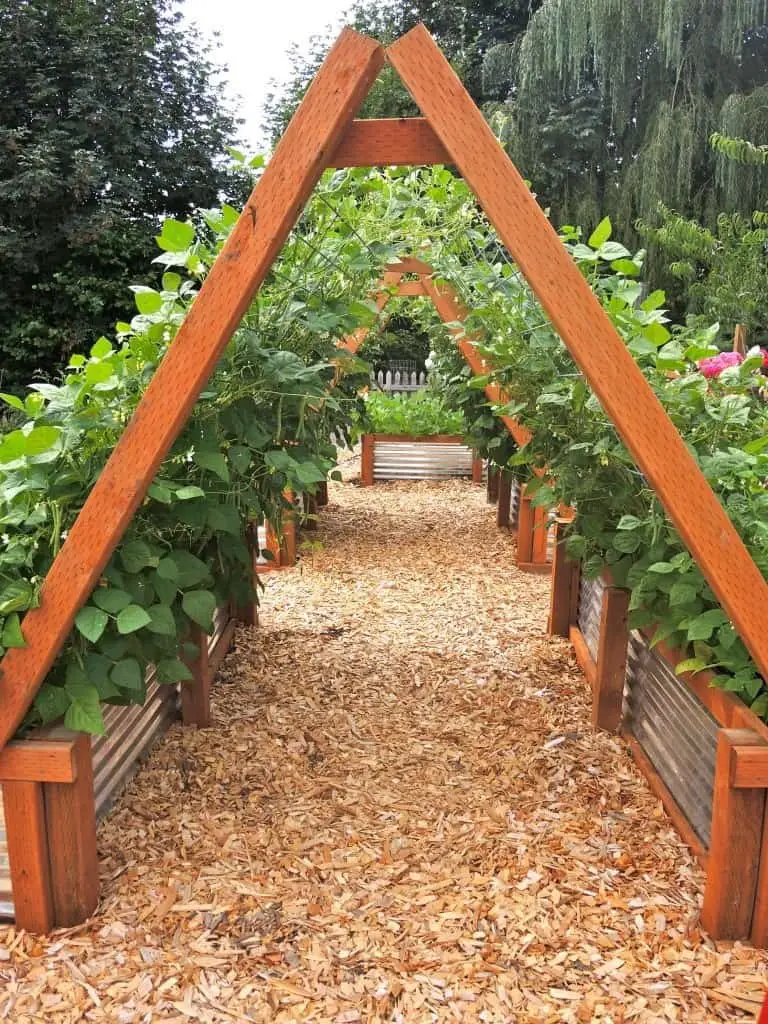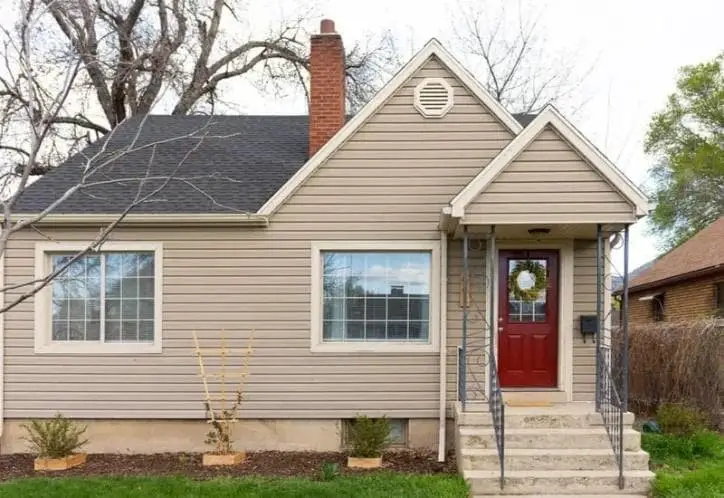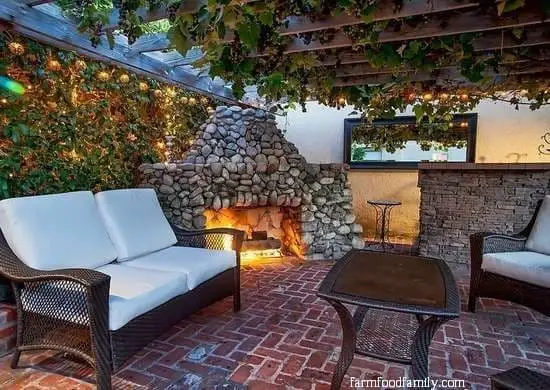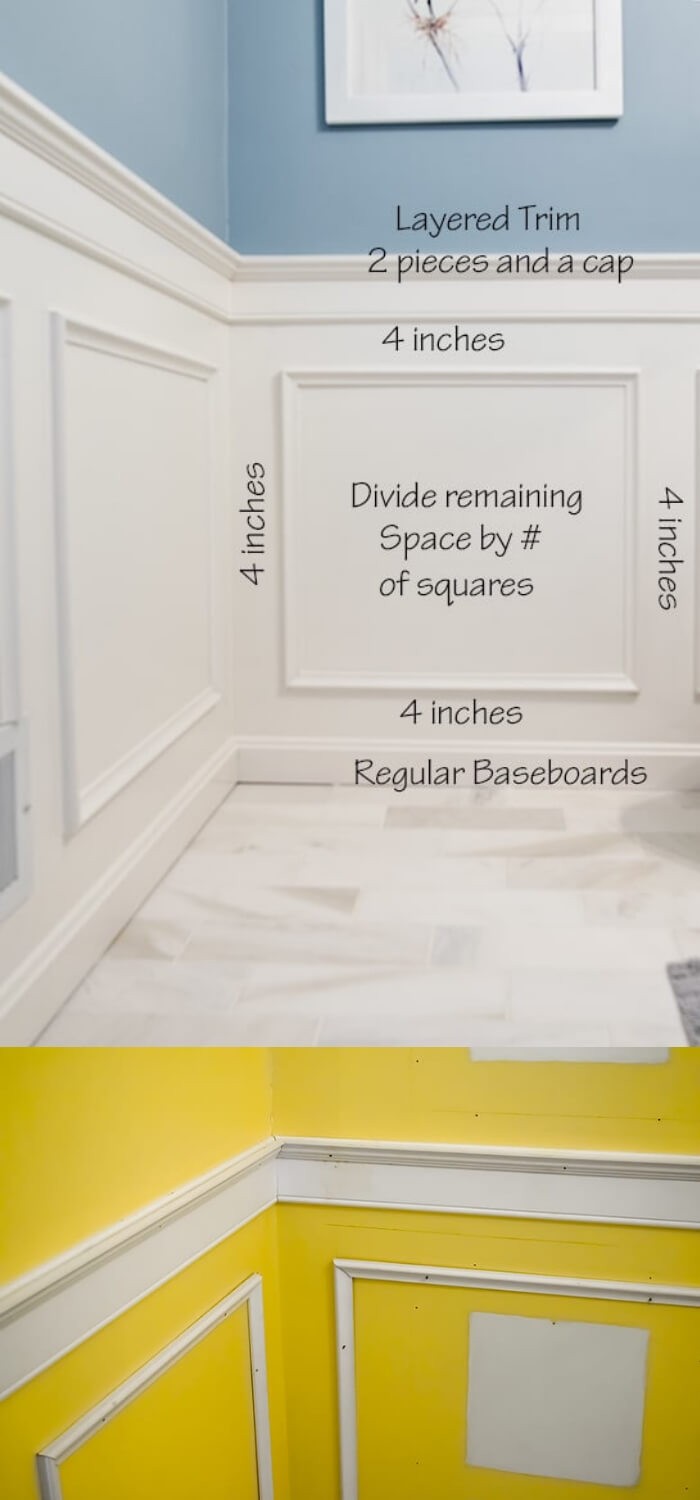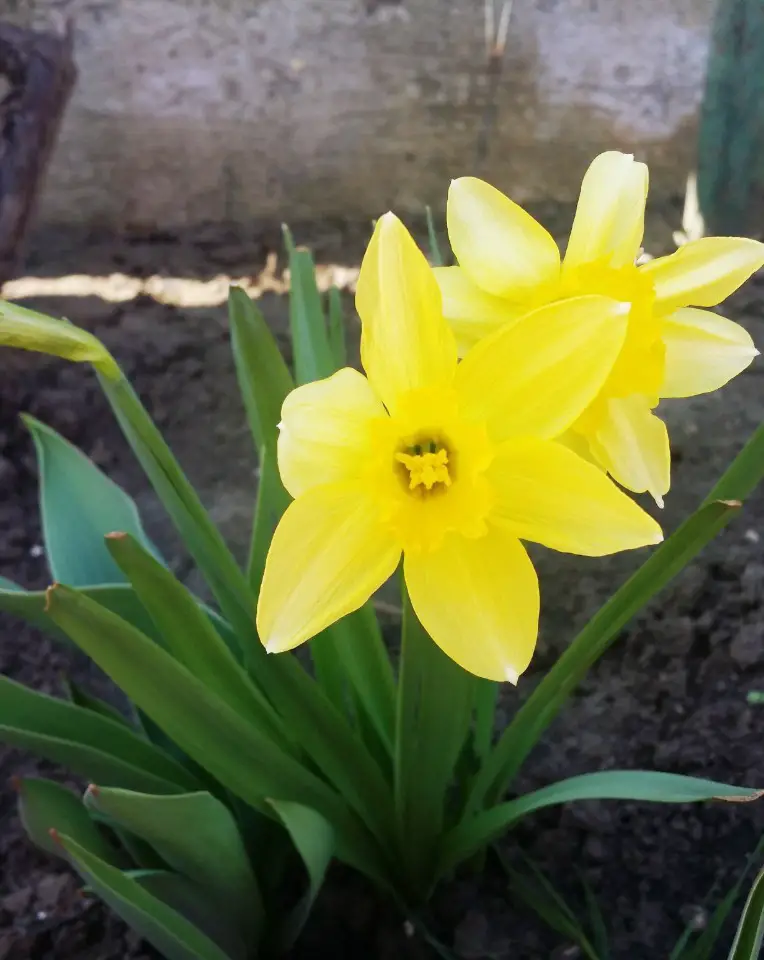24 Best Plants For Around The Pool Top Picks For 2024
When it comes to poolside landscaping, the key to a stunning oasis is finding the right balance between form and function. Not only do the right plants add aesthetic appeal, but they can also create a more enjoyable and functional outdoor space for you and your family. In this article, we’ll explore the top considerations for choosing poolside plants, from climate and hardiness to pool chemical tolerance and debris management.
We’ll then dive into our top 24 picks for poolside plants that are both beautiful and durable. Whether you’re looking to create a shaded retreat or a vibrant display of color, we’ve got you covered. By considering factors like root structure, maintenance needs, and design tips, you can transform your pool area into the ultimate hangout spot.
Considerations for Choosing Poolside Plants
When it comes to decorating your pool area, selecting the right plants can be a crucial decision. To ensure they flourish and don’t become a nuisance, consider a few key factors. For instance, you’ll want to think about how much sunlight the area receives, as well as its soil quality and water requirements. By taking these factors into account, you can create a thriving and visually appealing poolside landscape that’s both functional and beautiful.
Climate and Hardiness
When selecting plants for your outdoor space, it’s crucial to consider the local climate. If you reside in a region with scorching sun, look for species that can withstand extreme temperatures without wilting or becoming scorched. Similarly, if you’re in an area prone to frost, choose plants that are tolerant of cooler conditions and won’t succumb to cold snaps.
By opting for plants that are naturally resilient to your climate, you’ll enjoy a low-maintenance outdoor space that requires minimal care throughout the year.
Pool Chemical Tolerance
While it’s true that both pools and plants thrive in the presence of water, there are some key differences when it comes to the chemistry involved. Pools often require chlorine or salt, which can be detrimental to certain plant species. However, there are plants that are more resilient and can tolerate these conditions, allowing them to stay healthy and vibrant even when exposed to pool water.
To achieve this, it’s essential to select plants that are known for their resistance to chlorine or saltwater. By doing so, you’ll ensure that your poolside plant companions remain fresh and flourishing.
Root Structure
When it comes to landscaping around your pool, it’s essential to choose plants with compact root systems that won’t encroach on your pool area. By selecting plants that don’t have invasive roots, you’ll avoid the hassle of dealing with cracked pools and costly repairs. Instead, focus on species that are naturally more contained in their growth, allowing you to enjoy a beautiful and functional outdoor space without worrying about hidden damage.
Debris and Maintenance
For those who prioritize simplicity and minimal effort, selecting low-maintenance plants is a great way to maintain a tidy pool area without the hassle of frequent cleanup. Some plants are notorious for dropping leaves, petals, or seeds, turning your once-pristine space into a messy scene after a gentle breeze. By opting for varieties that keep their debris to themselves, you’ll enjoy a reduced cleaning schedule and more time to relax by your pool.
The 24 Best Plants Around the Pool
Transforming your pool area into a serene tropical oasis is a wonderful way to elevate its aesthetic appeal and create an inviting outdoor living space. To achieve this, it’s essential to select the right plants that can thrive in the unique conditions surrounding your pool. Here, we’ll explore some of the most effective options for creating a lush paradise that will make you want to spend more time soaking up the sun.
Banana Plant ‘Basjoo’
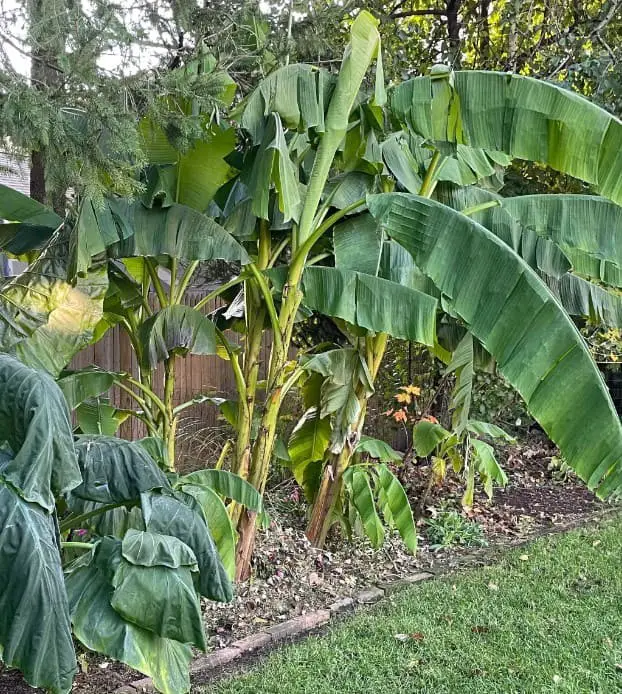
The Banana Plant ‘Basjoo’ is a tropical gem that effortlessly brings a lush and exotic ambiance to poolside settings. Characterized by its remarkable growth rate and striking, large leaves, this ornamental plant serves as the perfect natural screen, offering privacy and a dense green backdrop. Unlike fruiting banana plants, ‘Basjoo’ is primarily grown for its aesthetic appeal and has the added advantage of being extremely cold-hardy, making it an excellent choice for various climates.
With the ability to thrive in USDA Hardiness Zones 5 to 11, this plant can be enjoyed by a wide range of gardeners. Its creamy yellow flowers add a touch of elegance, while its tolerance for full sun to partial shade and moist, well-drained soil make it easy to care for. Reaching up to 18 ft. tall and 10 ft. wide at maturity, ‘Basjoo’ is an excellent option for gardeners seeking a statement piece that can withstand temperatures as low as -10°F when properly mulched.
Banana Tree (Musa)
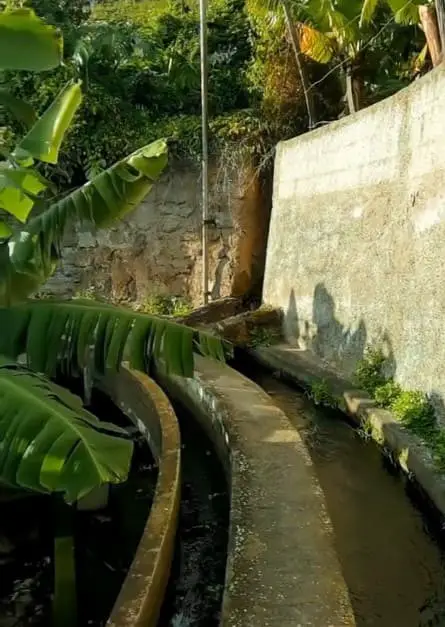
The banana tree (Musa) is a popular choice for those seeking a tropical ambiance, offering large, broad leaves that provide ample shade and visual appeal. This fast-growing tree can rapidly add height and lush greenery to your pool area, making it an excellent option for those looking to create a tropical oasis.
With a range of USDA Hardiness Zones from 9 to 11, banana trees thrive in warm climates with full sun exposure.
They require rich, well-drained soil and can grow up to 10-20 feet tall and 6-10 feet wide. However, they do need protection from strong winds and regular fertilization to flourish.
While best suited for warmer regions, banana trees can be grown in pots in cooler climates and moved indoors during winter. This adaptability makes them a versatile choice for those seeking to bring a touch of the tropics into their outdoor or indoor spaces.
Bird Of Paradise (Strelitzia reginae)
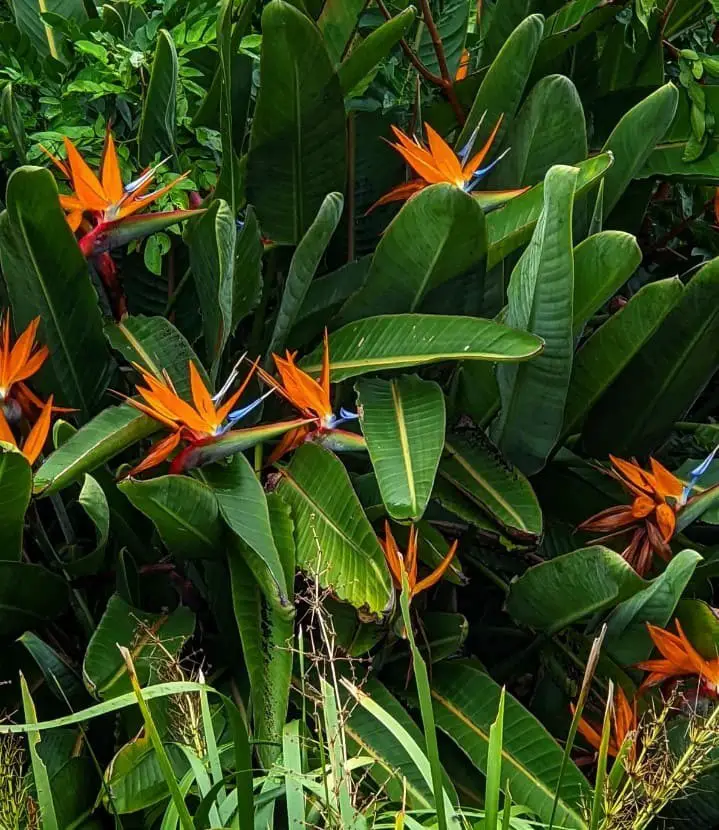
The iconic Bird of Paradise plant, with its vibrant orange and blue flowers that evoke the image of birds in flight, is a standout feature in any garden setting. This exotic beauty thrives in sunny, tropical environments and is often used to elevate the ambiance of luxury pool areas.
Native to USDA Hardiness Zones 10 to 12, this stunning plant requires full sun to partial shade and rich, well-drained soil to reach its mature size of 4–6 ft. tall and 2–3 ft. wide.
With proper care, including consistent moisture and occasional feeding, the Bird of Paradise can bloom multiple times a year, each spectacular display adding drama and color to your poolside landscape.
Canna Lily (Canna indica)
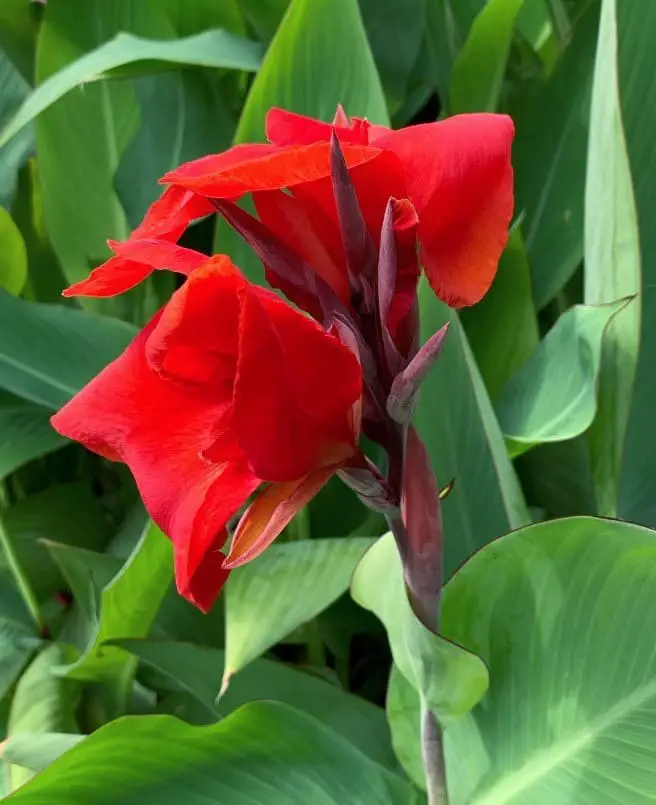
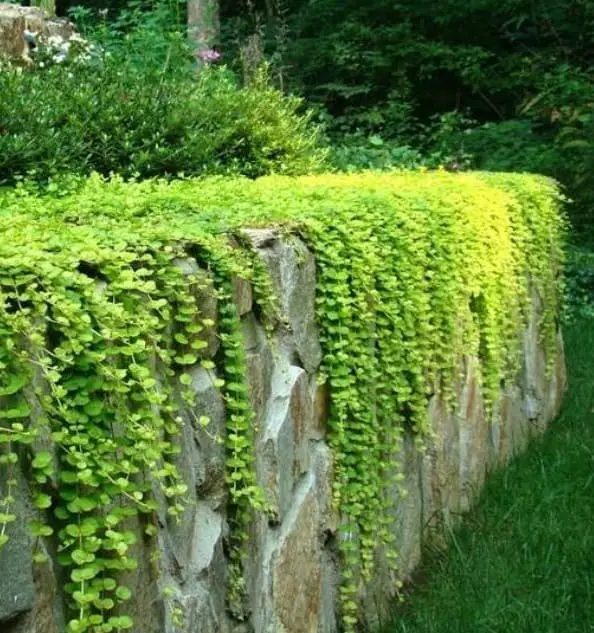
Both Canna Lilies and Creeping Jenny are excellent choices for poolside areas, offering unique characteristics that make them well-suited for this environment. Canna Lilies boast large, tropical leaves and vibrant flowers that bloom throughout the summer, providing a continuous pop of color alongside green foliage. They’re available in a variety of colors, including red, orange, yellow, and pink.
These plants thrive in full sun and moist, well-drained soil, growing up to 5 feet tall and 2 feet wide. In contrast, Creeping Jenny is a vigorous ground cover with bright, lime-green leaves that spreads quickly to form a soft, mat-like carpet. It’s perfect for areas near pools where splashes are common, as it thrives in moist conditions.
This plant can grow up to 2 inches tall and spreads indefinitely, making it an excellent choice for softening the edges of hardscapes or cascading over the sides of pots and planters. Both plants have similar requirements, including USDA Hardiness Zones of 3-11 for Canna Lilies and 3-9 for Creeping Jenny. They both prefer full sun to partial shade and moist, well-drained soil.
However, Canna Lilies require regular watering, especially in hot weather, and benefit from a monthly dose of fertilizer during the growing season. After the first frost, the rhizomes can be dug up and stored indoors in colder climates. Creeping Jenny, on the other hand, is relatively low-maintenance and doesn’t require as much attention. It’s an adaptable plant that can thrive in both sun and shade, but ensure it has enough moisture to prevent drying out.
Echeveria (Crassulaceae)
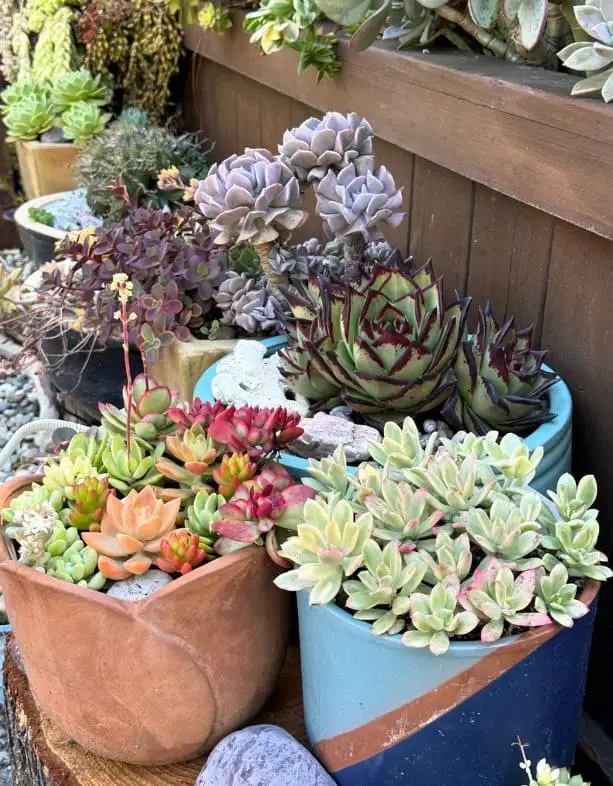
Echeveria, a stylishly popular succulent, showcases vibrant rosettes of waxy leaves in an array of hues including greens, blues, and purples. The leaf tips often feature stunning accent colors, making them a standout addition to any poolside or garden setting. With their remarkable drought tolerance, established Echeverias require minimal care, making them perfect for sunny areas surrounding the pool.
These plants can thrive in hot, dry conditions due to their water-storing leaves, allowing them to flourish without excessive watering. Whether used in a rock garden, mixed succulent container, or as a solo statement piece, Echeverias bring a modern touch and effortless elegance to any outdoor space. They are adaptable to USDA Hardiness Zones 9-11 and thrive in full sun with well-drained, sandy soil conditions.
Their mature size typically ranges from 6 inches to 12 inches tall, making them an ideal choice for poolside plantings or garden arrangements.
Egyptian Papyrus (Cyperus papyrus)
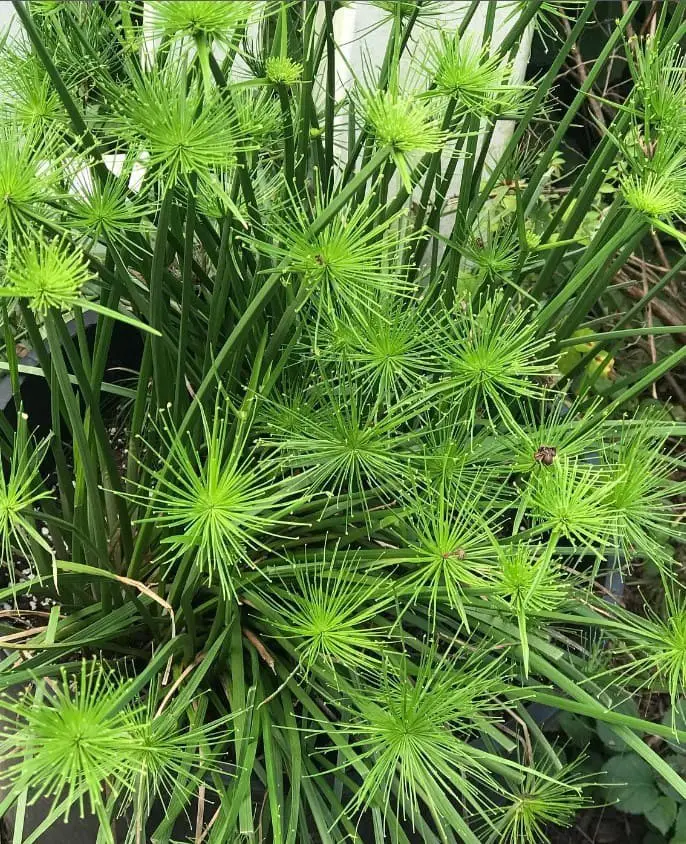
The Egyptian Papyrus boasts an unmistakable grass-like appearance, with its delicate, umbrella-shaped tufts gracing the ends of the stalks. As a naturally aquatic plant, it excels in wet environments and can even be directly planted in shallow pools or water gardens, where it will thrive.
This striking specimen is hardy in USDA zones 8 to 11, producing inconspicuous greenish-brown blooms that add little visual interest.
It demands full sun to partial shade and thrives in soggy, bog-like soil conditions, reaching mature heights of 5 to 8 feet.
When planted around pool areas, the Egyptian Papyrus can create a lush, tropical ambiance, bringing dramatic height and depth. Planted en masse, it is particularly effective as a visual screen around the pool, providing an added layer of seclusion.
Fountain Grass (Pennisetum)

Fountain Grass, a clump-forming ornamental grass, boasts versatility and rapid growth. Its feathery plumes are prized for their beauty and hardiness, making them an attractive addition to any garden. The arching stems and flowing seed heads sway elegantly in the breeze, providing movement and soft texture to the surrounding landscape. Growing conditions for Fountain Grass include USDA Hardiness Zones 5-9, with optimal flower colors ranging from pink to purple to white.
It thrives in full sun and well-drained soil. Maturity is reached at 2-3 feet tall, making it an ideal choice for poolside settings or as a border accent. In its natural habitat, Fountain Grass adds both color and elegance to the surrounding area. Regular trimming in late winter maintains a tidy appearance while encouraging new growth in spring.
Fox Tail Agave (Agave attenuate)
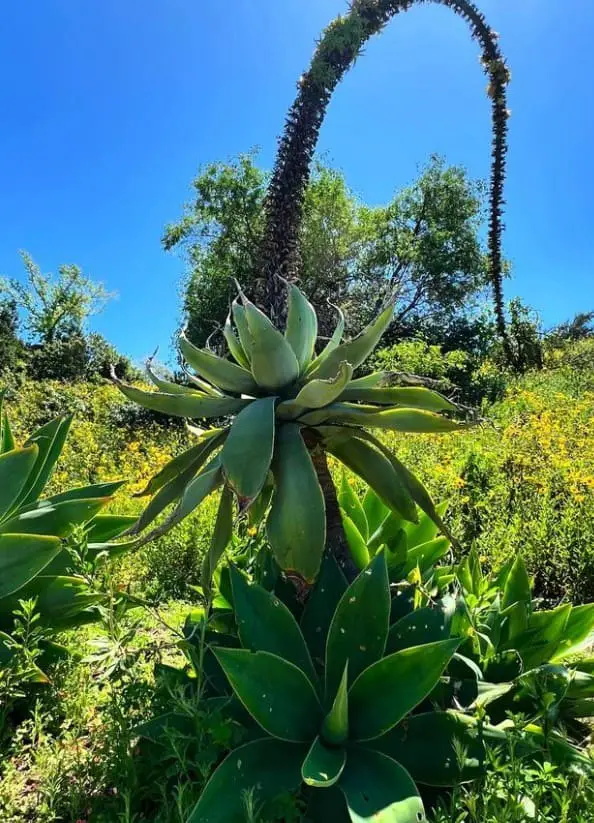
The Fox Tail Agave is a statement piece in any outdoor setting, boasting a stunning rosette of smooth, blue-green leaves that add a touch of sophistication to poolside spaces. Its namesake feature – the curved stem resembling a fox’s tail – only adds to its unique charm. This low-maintenance wonder is perfect for those seeking a high-impact plant without the hassle.
This agave variety flourishes in hot, arid conditions, making it an excellent choice for sunny pool areas.
Once established, it’s remarkably drought-tolerant and requires minimal watering, only demanding ample space to showcase its full glory. As such, it’s well-suited for transforming your pool area into a modern desert landscape that’s equal parts striking and serene.
Frangipani (Plumeria)
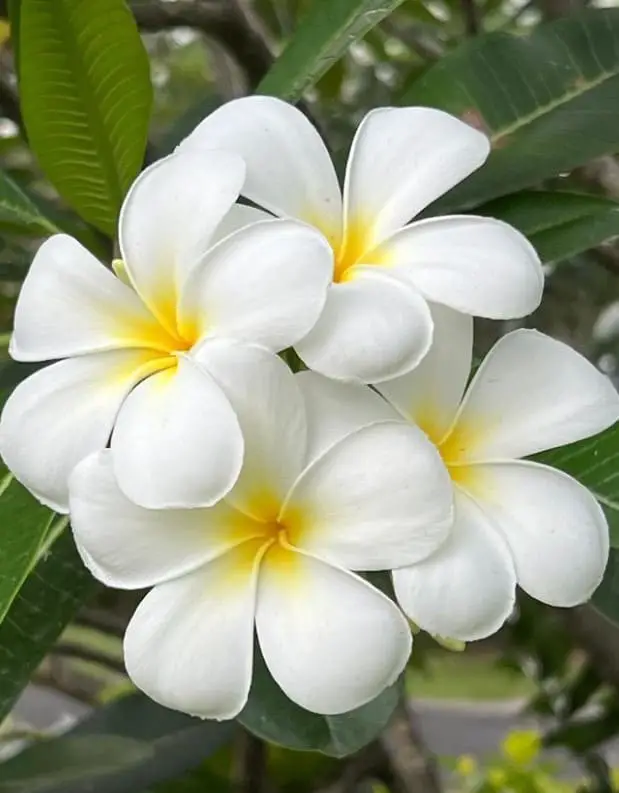
The frangipani, also referred to as Plumeria, is a tropical tree renowned for its alluring fragrance and vibrant flowers that come in a range of colors from pure white and sunny yellow to soft pink and deep red. This ornamental tree brings a lush, exotic ambiance to poolside environments, often evoking feelings of luxury and serenity.
USDA Hardiness Zones: 10 to 12
Flower Color: A palette of whites, pinks, yellows, and reds
Lighting Conditions: Full sun
Soil Requirements: Well-drained soil
Mature Size: 8 to 20 feet in height and width
As a perfect addition to any backyard oasis, the frangipani requires some care to flourish, particularly when it comes to watering and nourishment during its growing season. However, the sensory delights of its blooms make every effort well worth it.
Hawaiian Hibiscus (Hibiscus rosa-sinensis)
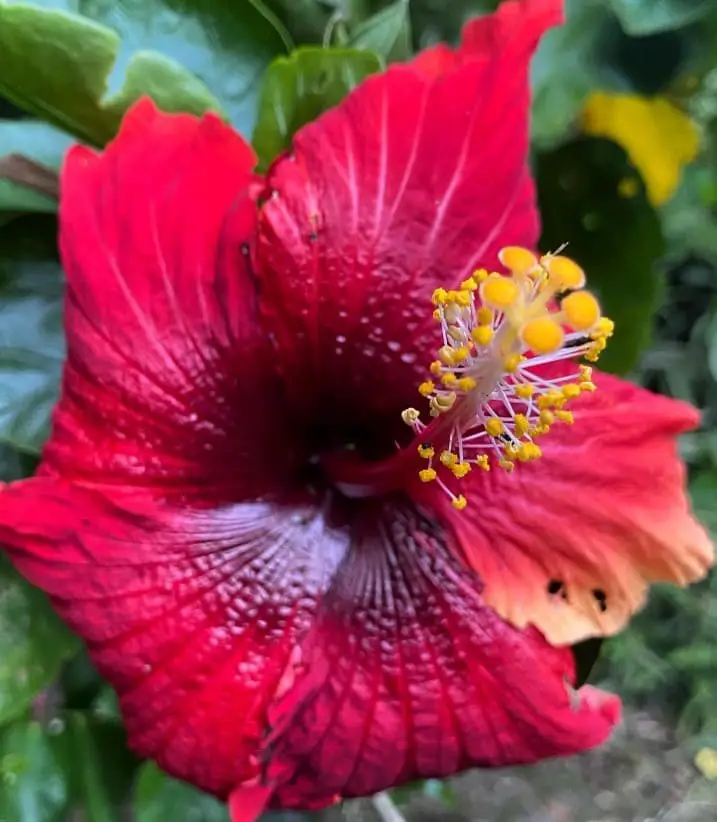
Hawaiian Hibiscus, with its vibrant blooms and tropical charm, is a popular choice for bringing a touch of paradise to any outdoor space. Its showy flowers come in a kaleidoscope of colors, making it easy to incorporate into your poolside design. From bold reds and oranges to soft yellows and whites, there’s a Hibiscus hue to suit every taste.
When it comes to growing conditions, Hawaiian Hibiscus thrives in USDA Hardiness Zones 9-11, where it can bask in full sun or partial shade.
Its well-drained, fertile soil needs are met with ease, and it grows into a mature size of 4-8 ft tall and wide.
While Hibiscus does require some protection from the coldest temperatures, it’s generally low-maintenance and easy to care for. With regular watering and fertilization, you can enjoy its profuse blooms throughout the warmer months.
Hebe (Hebe)
Hebe is an excellent option for adding visual interest and color to your poolside landscape. Its evergreen foliage and spiky flowers, which attract butterflies and bees, make it a popular choice among gardeners. With a range of sizes available, Hebe can be used as ground cover or border highlights, offering versatility in its design applications.
This shrub is hardy in USDA zones 7-10 and thrives in conditions with full sun to partial shade, well-drained soil, and mature sizes ranging from 1 to 5 feet tall and wide. Hebe requires minimal maintenance but benefits from occasional pruning to maintain its shape and encourage flowering.
One of its standout features is its tolerance for salt and wind, making it an effective choice for coastal or windy areas.
Hens and Chicks (Sempervivum tectorum)
Hens and Chicks succulents are a charming addition to any rock garden or dry spot near your pool. Characterized by dense mats of rosettes, the main ‘hens’ produce smaller ‘chick’ rosettes that grow from them. This hardy plant is well-suited for USDA zones 3-8 and can thrive in full sun with well-drained soil.
Its mature size ranges from 6 inches tall to 12 inches wide, making it a compact choice for any garden bed or container.
Notably, Hens and Chicks are extremely easy to care for, requiring only occasional watering and tolerating poor soil conditions where other plants might struggle. This low-maintenance quality makes them an excellent option for creating a beautiful yet water-wise poolside garden.
Indian Hawthorn (Rhaphiolepis indica)
The Indian Hawthorn is a resilient evergreen shrub that thrives in poolside environments due to its exceptional salt tolerance and ability to withstand direct sunlight. Its dense, mound-like growth habit makes it an excellent choice for creating lush borders or mass plantings. In the spring, the plant erupts with clusters of delicate pink or white flowers, which provide a beautiful contrast to its glossy, dark green foliage.
Once established, this shrub is remarkably drought-tolerant and exhibits resistance to most pests and diseases, making it an ideal option for gardeners seeking low-maintenance landscaping solutions around pools. Indian Hawthorn can be grown in USDA Hardiness Zones 7 to 11, and prefers well-drained soil with full sun to partial shade. Its mature size ranges from 2 to 4 feet tall and wide, making it a versatile addition to any outdoor space.
Jade (Crassula ovata)
The jade succulent is a stylish addition to any poolside setting, boasting thick, woody stems and oval-shaped leaves with a rich jade-green hue that may develop subtle red tips in direct sunlight. As an added bonus, mature plants can produce delicate white or pink star-shaped flowers during the winter months, further enhancing their charm.
With its ability to thrive in full sun to partial shade conditions, this low-maintenance succulent is well-suited for warm, dry environments often found near pools. Its compact size of 2-5 feet tall and 2-3 feet wide makes it an ideal choice for container planting, allowing for strategic placement around pool decks to create a visually appealing display.
Kangaroo Paw (Anigozanthos flavida)
Kangaroo Paw stands out with its distinctive, fuzzy blooms that evoke the image of a kangaroo’s paw. This unique feature makes it an attractive addition to any garden. The plant’s tubular flowers not only provide a striking visual display but also serve as a haven for nectar-loving birds. Its vibrant hues range from fiery red and orange to soothing green and yellow, offering something for every aesthetic.
The Kangaroo Paw thrives in USDA Hardiness Zones 9 to 11, where it can bask in the warmth of full sun. It’s particularly well-suited for hot, dry climates with sandy soils, making it an excellent choice for pool areas or coastal gardens. To keep this plant looking its best, regular deadheading of spent blooms is essential. This simple maintenance task encourages more flowering and preserves the vibrant colors.
Martha Washington Geranium (Regal pelargonium)
Martha Washington Geranium, also referred to as Regal Geranium, is a vibrant addition to any outdoor space with its showy, large flowers. The blooms come in an array of colors, including whites and pinks, deep reds, and purples, often featuring intricate veining or patterns that add depth and visual interest.
This geranium thrives in USDA Hardiness Zones 10 to 12, but can be grown as an annual in cooler climates.
It produces flowers in shades of white, pink, red, and purple, and prefers full sun to partial shade.
To keep the plants healthy, they require well-drained soil. They typically reach a mature size of 1 to 2 feet tall and wide, making them an excellent choice for containers and hanging baskets.
For optimal growth, these geraniums prefer cooler spring temperatures and may need some afternoon shade in hotter climates to protect their blooms from the intense heat.
This makes them well-suited for strategically placing around pools or other outdoor spaces to add a pop of color during the warmer months.
Ornamental Sweet Potato Vine (Ipomoea batatas)
Ornamental sweet potato vine is renowned for its remarkable growth rate and striking foliage, which comes in a range of hues including lime green, bronze, and purple. This versatile vine excels at creating a lush, tropical ambiance by swiftly spreading across the ground or spilling elegantly over containers.
In terms of hardiness, this plant thrives in USDA zones 9 to 11. Its flowers, which are rare in ornamental varieties, boast a delicate lavender color.
The ideal growing conditions for ornamental sweet potato vine include full sun to partial shade and well-drained soil. At maturity, the plant reaches a height of approximately 6 inches when used as a ground cover, while its trailing habit allows it to climb up to 10 feet.
Star Jasmine (Trachelospermum jasminoides)
Star Jasmine is a highly adaptable evergreen vine renowned for its intoxicatingly sweet fragrance and striking glossy green foliage. This versatile plant excels at creating natural privacy screens or lush green walls around pools, and can be trained to climb trellises, sprawl along fences, or spread as ground cover. Its unique features make it an ideal choice for homeowners seeking a low-maintenance yet visually stunning addition to their outdoor spaces.
Thriving in USDA Hardiness Zones 8-11, Star Jasmine boasts white flowers that bloom in late spring and early summer, releasing a potent fragrance that can elevate the poolside experience. Its robust nature allows it to tolerate drought once established and requires minimal care beyond occasional pruning to maintain its shape and encourage denser growth. With a mature size of up to 20 ft.
long when trained on a trellis, Star Jasmine is an excellent option for those seeking a statement piece that won’t break the bank or demand excessive upkeep.
Zebra Grass (Miscanthus sinensis ‘Zebrinus’)
Zebra Grass brings an eye-catching combination of green blades with horizontal gold bands to any outdoor space, introducing a dynamic visual contrast that captures attention. The ornamental grass is prized for its statuesque, arching foliage and delicate, feathery plumes that unfurl in late summer, persisting into winter’s chill to provide extended visual appeal.
Zebra Grass thrives in USDA Hardiness Zones 5-9, boasting copper-hued flowers that gradually transform to a silvery sheen as they mature. It requires full sun, well-draining soil with moderate moisture levels, and can grow up to 7 feet tall and 5 feet wide at maturity. This striking grass is an excellent choice for adding texture and visual interest to poolside landscapes.
Its slender stems sway effortlessly in the breeze, serving as a stunning backdrop for smaller plants or forming part of a mixed border. Zebra Grass also boasts remarkable hardiness, requiring minimal care once established, and it doesn’t spread aggressively, making it easy to manage in a garden setting.
Aeonium (Aeonium)
Aeoniums are a type of succulent that adds an artistic touch to any outdoor setting. Their distinctive rosette-shaped leaves and sculptural beauty make them a perfect choice for poolside gardens or rock gardens. These plants thrive in well-drained soil and mild climates, making them ideal for areas with minimal watering requirements. They’re also great for creating modern, low-maintenance landscapes that require little maintenance.
With mature sizes ranging from 2 to 3 feet tall and wide, depending on the species, Aeoniums can be easily incorporated into any outdoor design. When planted alongside softer-textured plants, they create a striking contrast that provides a year-round focal point with their unique form.
Agave Attenuata (Agave attenuata)
The Foxtail Agave (Agave Attenuata) is a sought-after choice for poolside gardens due to its striking architectural form and soft, smooth leaves. This low-maintenance agave thrives in full sun, making it an excellent option for those seeking a plant that can handle intense sunlight. Its unique rosette pattern and stunning flower spike add visual interest and structure to the poolside area.
This drought-tolerant agave is well-suited for warm climates and can be used to create a striking focal point with its distinctive, spiky appearance. It requires well-drained soil and can grow up to 5 feet tall and wide when mature. With USDA Hardiness Zones ranging from 9 to 11, this agave is perfect for regions with mild winters.
Angel’s Trumpet (Brugmansia)
Angel’s Trumpet, with its showy, fragrant blooms, makes a striking addition to any poolside landscape. The plant’s dramatic flowers, which can grow up to 20 feet tall, exude a pleasant aroma in the evenings, especially when placed in areas with full sun to partial shade. To maintain its lush, tropical appearance, this plant requires regular watering and feeding. However, it does demand more attention than some other plants, as its soil needs are specific – rich and well-drained.
This beautiful yet toxic plant thrives in USDA Hardiness Zones 9 to 12, producing flowers that vary from white to pink, yellow, or orange. It’s essential to exercise caution when planting Angel’s Trumpet, especially if pets or children frequent the area, as all parts of the plant are poisonous if ingested.
Design Tips for Poolside Plant Arrangement
Transforming your pool area into an inviting oasis is not just about adding some greenery, but rather crafting a setting that turns every pool day into a mini-vacation from the daily grind. To achieve this harmony of form and function, let’s dissect the essential elements that will turn your outdoor space into a true retreat.
Creating Zones
Before diving into the details, consider the distinct zones within your pool’s microclimate. The varying levels of sunlight, breeze, and shade create unique environments that require different approaches to landscaping. It’s essential to think about where the sun-loving plants will thrive, while more sensitive greens are better suited for shaded areas. This subtle attention to detail is crucial in creating a harmonious and inviting atmosphere around your pool, regardless of the weather.
Height and Texture
When it comes to designing your poolside oasis, it’s essential to consider two key elements: height and texture. Gone are the days of flat, monotonous spaces. Instead, aim to create visual interest by incorporating layers that draw the eye. This can be achieved through a combination of tall plants, short shrubs, and everything in between. But it’s not just about varying heights – texture plays a significant role too. Think about pairing smooth-leaved banana plants with delicate fern fronds.
The contrasting textures not only create visual harmony but also keep things engaging, transforming your poolside into a stunning focal point.
Color Coordination
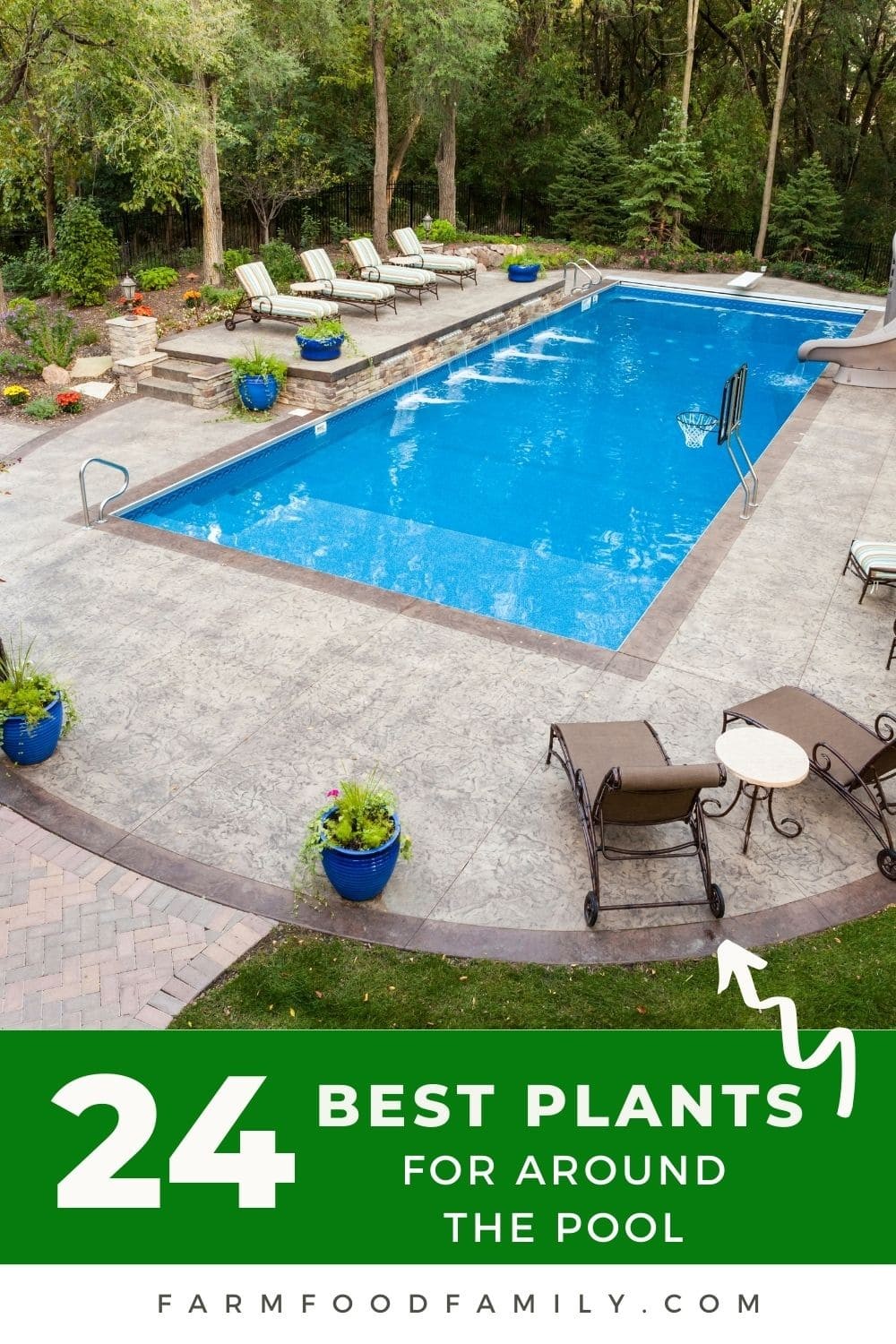
Ultimately, when it comes to color coordination around your pool area, it’s not just about matching colors; it’s about creating a harmonious space that visually flows together seamlessly. This means considering the overall aesthetic you want to achieve, whether that’s a calming oasis or a vibrant retreat. Think about how different shades of blue and green can work together to create a sense of serenity, or how pops of brighter hues can add energy and excitement.
Whatever your design style, remember that the colors you choose should complement both the pool and surrounding decking, resulting in a cohesive look that ties everything together.
Maintenance Tips for Poolside Plants
Maintaining the visual appeal of your poolside plants is an effortless endeavor. By adopting a handful of straightforward approaches, you can guarantee their optimal health and continued contribution to your outdoor sanctuary’s ambiance.
Watering Needs
Mastering the art of poolside plant care requires attention to their unique watering needs. While these plants often bask in the warm sunlight and reflected heat, they can be just as vulnerable to overwatering as they are to dehydration. To strike a balance, start by inspecting the soil before each watering session. If it’s still retaining moisture, consider giving your plants an extra day or two to dry out slightly.
This simple yet crucial step will ensure your poolside greenery thrives with optimal health and vitality.
To further refine your approach, refer to the following guidelines for specific plant types:
* Succulents: Water deeply but infrequently, allowing their thickened leaves to absorb and store moisture effectively.
* Tropicals: Require consistent moisture levels, so be prepared to water regularly to keep them happy and thriving.
* Ornamental Grasses: Fall somewhere in between, tolerating moderate to high levels of moisture. Allow the topsoil to dry out slightly before rehydrating your grasses.
By adopting this thoughtful approach to poolside plant care, you’ll be rewarded with lush, resilient foliage that will delight both you and your poolside visitors.
Pruning and Care
Regular pruning is a crucial aspect of maintaining a thriving garden. By removing dead or dying leaves and stems, you’re allowing your plants to focus their energy on healthy growth. This practice isn’t just about aesthetics; it also plays a significant role in promoting plant health. Removing old growth can help prevent disease and pests from taking hold, ultimately giving your plants the best chance to succeed. When it comes to pruning, there are several key areas to focus on.
Deadheading flowers is an effective way to keep flowering plants looking their best while encouraging them to produce more blooms. Trimming back overgrowth helps control size and shape, ensuring a neat and tidy appearance in your garden. By incorporating regular pruning into your routine, you can expect to see significant improvements in the health and vitality of your plants.
Seasonal Adjustments
To maintain a thriving poolside garden, it’s essential to adapt your care routine according to the changing seasons. This is particularly crucial in areas with significant temperature fluctuations. Here are some tailored tips to keep your plants in optimal condition: As the seasons transition, make sure to tidy up any debris and dead plant material left over from winter. Once new growth begins, start fertilizing to promote healthy development.
In contrast, as fall approaches, cut back on watering to allow plants to slow down for the approaching winter. For sensitive plants, consider applying a protective layer to shield them from frost. To break it down further, here’s a season-by-season task list:* Spring: Prune dead winter growth to encourage new growth and fertilize for optimal development.* Summer: Closely monitor water levels to prevent heat stress and keep your plants hydrated.
* Fall: Begin reducing watering as plants start to slow down, preparing them for dormancy.* Winter: Protect sensitive plants from frost if necessary, taking steps to prevent cold damage. By adjusting your care routine seasonally, you can rest assured that your poolside garden will remain a stunning feature of your home all year round.
Common Problems and Solutions for Poolside Plants
When it comes to cultivating a vibrant poolside garden, several obstacles can arise. Pests and the corrosive impact of pool chemicals are just two examples of the challenges that may threaten the health of your plants. To ensure your garden remains lush and resilient, it’s essential to implement effective strategies for managing these issues and more.
Pest Control
When it comes to dealing with pests in your pool area, you’re not alone. Fortunately, there are natural and chemical-free ways to keep these unwanted visitors at bay. One approach is to introduce beneficial insects like ladybugs and lacewings that feed on common pests like aphids. Another option is to incorporate aromatic herbs such as lavender and rosemary into your poolside landscape. These plants naturally repel many insects while adding a pleasant touch to the surrounding area.
To get started, here’s a simple guide:
Pests | Natural Repellent | Plant Examples
Aphids | Ladybugs, Lacewings | Lavender, Rosemary
Mosquitoes | Citronella, Marigolds | Citronella Plants
Beetles | Neem Oil, Garlic Spray | Garlic Plants
These natural methods not only work effectively but also ensure a safe and enjoyable poolside experience for everyone.
Disease Prevention
To maintain a thriving poolside garden, it’s essential to address disease prevention. The humid environment surrounding pools can be conducive to the growth of plant diseases like mildew or rot. To mitigate this risk, prioritize good air circulation by not overcrowding your plants and prune regularly to remove any potentially diseased foliage. Additionally, selecting disease-resistant plant varieties from the start is a great strategy.
By implementing these practices, you can substantially reduce the likelihood of diseases affecting your plants, ensuring your poolside oasis remains healthy and radiant.
Repairing Plant Damage
To conclude our discussion on keeping plants healthy near pools, it’s essential to address the issue of repair and recovery from salt or chlorine damage. These chemicals can cause significant stress and even leaf burn in plants. If you notice your plants showing signs of distress after a pool party, take immediate action by gently rinsing them with fresh water to remove any chemical residue.
For long-term protection, consider implementing barriers such as decorative rocks or raised planters to shield your plants from splashback. By adopting these simple yet effective strategies – including lightly spraying plants with fresh water after heavy pool use and using physical barriers to minimize contact with pool water – you can help your plants recover and thrive despite the challenges they face in this environment.

